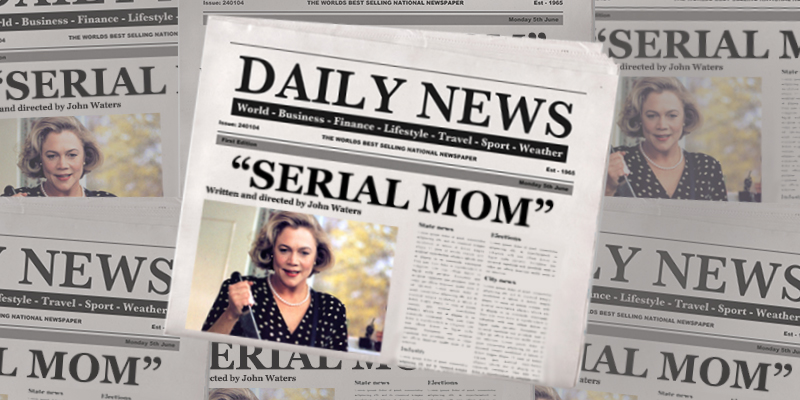America’s serial killer obsession is bottomless, a seedy fixation with inexplicable horror. It often glorifies murderers in its attempts to psychologize those who kill without any discernable motive, and to draw comfortingly clear lines between good and evil. This obsession was a perfect target for the provocative director John Waters, who takes such joy in exposing the dark side of American culture. Waters’ film Serial Mom, a box office bomb that became a cult classic, perfectly satirizes serial killer mania. His parody of true crime stories, and the media circus they attract, reveals the perverse desires and anxieties of American life.
Serial Mom is not as delightfully obscene as other Waters films (like Polyester and Desperate Living), that tear down the façade of picture-perfect suburban life. But its cultural criticism of true crime sleaze is pleasingly cynical and sharp. The film is dead on when it skewers the craven media circus that always follows sensational crimes. And Waters goes for the jugular parodies of the moral panics of the 1990s, some of which are cropping up again today.
With his perverse tale of Beverly Sutphin, a happy homemaker who starts bumping off her friends and neighbors, Waters satirizes the format of true crime miniseries and “movies of the week” that were ratings gold in the ‘70s, ‘80s, and ‘90s. (These are often dismissed as retro trash, but they’re a clear influence on much of the prestige true crime adaptations we’re bombarded with today.) Serial Mom opens with title cards that mimic the typical true crime disclaimers: the film was based on interviews and witness testimony. And then, there’s the kicker: “Some of the innocent characters’ names have been changed in the interest of a larger truth.” True crime fiction often puts quotation marks around itself like this, both to protect themselves from liability, and to make a case for its own cultural legitimacy. Waters, mimicking this, makes his satire reveal larger truths about American values and obsessions.
*
This is not to say that Waters does not believe that true crime can’t get at bigger ideas. Serial Mom illustrates how true crime’s thirst is slaked by the sordid, but also the unlikely—crimes that shake the social order. The improbability that a sweet-as-pie housewife could be overtaken by bloodthirsty urges was catnip for the true crime genre. Waters’ serial mom, Beverly, was almost certainly influenced by the real-life murderer Betty Broderick. Broderick, a wealthy suburban mother, killed her ex-husband and his new wife after an acrimonious divorce. Her case fascinated the nation. If Broderick, a picture-perfect Super Mom, could suddenly “snap” and become a killer, what were other seemingly-contended housewives capable of?
Real-life crimes rise to the level of true crime obsessions when they touch on the “larger truths” of contemporary cultural anxieties. The Broderick saga was aired on Court TV, and it inspired not one, but two, beloved Lifetime movies of the week. Broderick became a kind of folk hero to women who got had gotten shafted in their divorces because the courts dismissed the value of their unpaid labor of housekeeping and child care.
Serial Mom’s Beverly (played with deceptively sunny pep by Kathleen Turner) shares Betty Broderick’s station wagon, toothpaste grin and perky demeanor. If Betty was a Super Mom, Beverly is the Uber Mom—a domestic goddess perfectly attuned to her families’ need, but quick to chide them when they stray from propriety. We see Beverly’s cartoony maternal perfection right from the start of the film. In the sunny-gold light of her kitchen, Beverly deals out eggs and fruit salad with a smile. Beverly’s family is a vision of blissful suburban harmony. Her teenage children, Chip and Misty, are chipper and polite, giving each other only mild ribbings. Her husband Eugene, is teasing and avuncular. (He’s played by Sam Waterston, who was literally the embodiment of upright morality in his role as DA Jack McCoy on America’s then-most popular crime procedural, Law and Order.) But the tightly-wound Beverly lasers in on the one imperfection in the domestic scene: a fly that’s buzzing around her breakfast table. Beverly silently twitches, her eyes growing wilder until she can swat it dead.
When Beverly turns to murder, she targets those who, like the fly, threaten her perfect family life. She goes after the math teacher who threatens to fail her son and the heartthrob who rejects her daughter. Later, she goes after neighbors who violate the norms of suburban community: people who don’t recycle or don’t rewind their video store rentals. Turner plays a wonderful murderous mama. She switches seamlessly between naughty and nice. She’s blonde and rosy and shiny enough to be that unflappable Supermom, but Turner has an underlying earthy sensuality that really heightens Beverly’s heady lust for violence. The genuine relish with which Beverly goes in for the kill—whether spearing a teenage boy with a poker or going after her neighbor with a leg of lamb—is shocking, and also uncomfortably infectious. Waters hits on an insightful tension: while Beverly kills to protect her family and maintain suburban etiquette, her killing is a pressure valve that frees her from the strictures of her life.
Beverly’s crimes, and then her trial, mocks America’s serial killer obsession. After the FBI coined the term “serial killer,” decades of research tried to develop a “profile” of this type of murderer. By the time Serial Mom hit the theaters, the American public was already familiar with the concept of profiling from the hit film The Silence of the Lambs, where a psychological profile helped catch a serial killer. Mark Seltzer saw the public’s obsession with serial killers in the ‘90s as an effect of the growth of pop psychology. Seltzer called this phenomenon a “trauma culture,” where Americans grew to believe in the “abnormal normality of psychic pain.” In this environment, a serial killer provided the opportunity to psychologize. There were two sides to this: on the one hand, serial killers supposedly possessed a compelling assortment of abnormalities and symptoms that were ripe for analysis. On the other hand, if psychological traumas were so widespread, it was possible that serial killers could be close to home, hiding in plain sight. Beverly, the happy homemaker next door, confirms the public’s worst fears. As she remains unflappably chipper in public, in private, she marks of the serial killer. Profilers found that serial killers could be copycats who took inspiration from each other. Beverly has a serial killer scrapbook, and corresponds with Ted Bundy. She keeps books about other killers covered in the book jackets of birding books.
The fixation with serial killers was bound up with developments in mass media. The ‘90s saw an intensification in the media’s attention on crime: Court TV provided wall-to-wall coverage of trials like Broderick, and basic cable news stations like CNN turned to salacious cases to boost ratings. Serial Mom touches on the craven media coverage of crimes. After her arrest, Beverly’s son Chip becomes her manager, fielding requests for interviews and holding out for the biggest payday. There’s a stir when sitcom actress and exercise guru Suzanne Somers comes to the trial. She hopes to play Beverly in a made-for-TV movie portraying her as a “feminist heroine.”
Waters is perhaps most insightful when he ties America’s anxieties about serial killers to the moral panics that periodically grip the nation, sparking terror that pop culture was dangerous, especially to impressionable young people. Waters’ own films were often accused of having a corrosive influence on youths. In the decade before Serial Mom’s release, the Parents Music Resource Center, co-founded by future Second Lady Tipper Gore, stirred up fears about the violent and sexually explicit content in popular music. (They successfully lobbied the music industry to label music with explicit lyrics.) By the time of Serial Mom’s release, new anxieties had gained traction: there was panic about violence in video games, and, more disturbingly, thinly-sourced tales of Satanic cults corrupting, if not blatantly abusing, young people. Waters has fun thumbing his nose at these seemingly endless overreactions to the pleasures of youth culture. Beverly’s son Chip works at a video store, and he and his friends love gore and splatter movies. They eagerly watch ‘60s camp horror films like Herschell Gordon Lewis’ Blood Feast, and Tobe Hooper’s The Texas Chainsaw Massacre. The kids’ fixation disturbs their quiet suburban community: Chip’s math teacher attributes Chip’s poor grades to the horror movies he watches. But supposedly toxic pop culture, is, of course, a red herring: the real danger lies not in the son, but in his mother. (The poor math teacher will learn this the hard way when Beverly mows him down with her station wagon.) Apart from the films they watch, Chip and his friends are surprisingly wholesome; it is his seemingly wholesome mother who is the real danger. It’s Waters’ winking way of mocking and critiquing American mores, as well as the true crime tropes that so handily reflect the dark pleasures that put the lie to them.

















